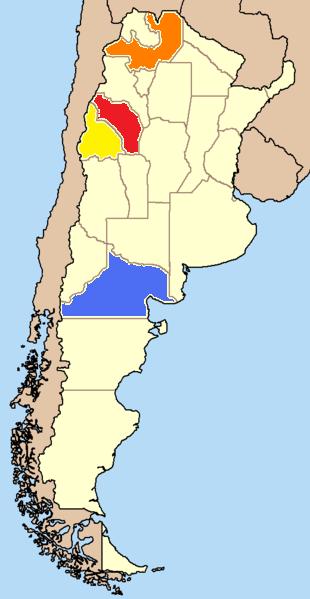|
Criollas (grape)
Criolla is a term used in the name of several grape variety, grape varieties, in particular varieties found in Argentine wine, Argentina, the most common of which is Criolla Grande and another which is Criolla Chica. The term Criollas is also used collectively to refer to a group of presumably American-born cultivars the European grapevine ''Vitis vinifera'', much in the same way as many other uses of the term ''Criollo''. The Criollas group of grape varieties also include e.g. the three Argentine Torrontés varieties (Torrontés Mendocino, Torrontés Riojano, and Torrontés Sanjuanino) and Torontel (also known as Moscatel Amarillo). A common feature of the Criollas group is a better resistance to certain types of environmental stress, such as low water availability and high salt concentrations, than many traditional European grape varieties. [...More Info...] [...Related Items...] OR: [Wikipedia] [Google] [Baidu] |
Grape Variety
This list of grape varieties includes cultivated grapes, whether used for wine, or eating as a table grape, fresh or dried (raisin, Zante currant, currant, sultana (grape), sultana). For a complete list of all grape species, including those unimportant to agriculture, see ''Vitis''. The term ''grape variety'' refers to cultivars (rather than the Variety (botany), botanical varieties that must be named according to the International Code of Nomenclature for algae, fungi, and plants). Single-species grapes While some of the grapes in this list are hybrids, they are hybridized within a single species. For those grapes hybridized across species, known as interspecific hybrids, see the section on #Multispecies hybrid grapes, multispecies hybrid grapes below. ''Vitis vinifera'' (wine) Red grapes White grapes Rose grapes ''Vitis vinifera'' (table) Red table grapes * Black Corinth * Black Monukka * Black Rose (grape), Black Rose * Cardinal (grape), Cardinal * Mazza ... [...More Info...] [...Related Items...] OR: [Wikipedia] [Google] [Baidu] |
Argentine Wine
Argentina is the fifth largest producer of wine in the world.H. Johnson & J. Robinson: ''The World Atlas of Wine'', pp. 300-301, Mitchell Beazley Publishing 2005 . Argentine wine, as with some aspects of Cuisine of Argentina, Argentine cuisine, has its roots in colonial Spain (wine), Spain, as well in the subsequent large Immigration to Argentina, Spanish and Italian immigration which installed its mass consumption. During the Spanish colonization of the Americas, vine cuttings were brought to Santiago del Estero in 1557, and the cultivation of the grape and wine production stretched first to neighboring regions, and then to other parts of the country. Historically, Argentine winemakers were traditionally more interested in quantity than quality. The country's wine industry exploded in the 1880s and into the early 20th century as the result of a rapidly growing population, the immigration of new producers, workers, and consumers from other wine regions (Italy and Spain), and the c ... [...More Info...] [...Related Items...] OR: [Wikipedia] [Google] [Baidu] |
Criolla Grande
Criolla Grande (also known as Criolla and Criolla Grande Sanjuanina) is a red wine grape commonly found in Argentina. It is different from the Chilean wine grape Pais, also known as ''Criolla Chica'', but ampelographers believe that both grapes share a common parent, and it is now listed as a crossing of Mission and Muscat of Alexandria. As of 2006, Criolla was the third most widely planted Argentine wine grape (22,500 hectares) after Cereza (30,000 hectares) and the more widely exported Malbec (24,400 hectares). It is primarily found in the Mendoza region. The grape has pink skin, which is thicker than in its Chilean cousin, Pais, and is used to produce deeply colored white wine. It is sometimes used to produce a light colored ''rosé''. The grape is rarely exported outside of Argentina where it is used to produce massive quantities of box and jug wines.J. Robinson (ed) ''"The Oxford Companion to Wine"'' Third Edition pg 210 Oxford University Press 2006 History The grape ... [...More Info...] [...Related Items...] OR: [Wikipedia] [Google] [Baidu] |
Criolla Chica
Pais is a red wine grape that has played a prominent role in the Chilean wine industry. Up until the turn of the 21st century, it was Chile's most planted variety until it was overtaken by Cabernet Sauvignon. Today it is most commonly used in the production of jug wine in the Bío-Bío, Maule and Itata River regions in the south. The grape is sometimes known as ''Negra Peruana''. In Argentina the grape is known as ''Criolla Chica''. J. Robinson (ed) ''"The Oxford Companion to Wine"'' Third Edition pg 503 Oxford University Press 2006 History The Pais has one of the longest viticultural history in Chile, believed to have been brought to the region by Spanish conquistadors from Peru during their colonization of the continent in the 16th century. Ampelographers believe that along with the Criolla Grande grape of Argentina and Mission grape of California, that the Pais grape is descended by the Spanish "common black grape" brought to Mexico in 1520 by the Spanish conquistad ... [...More Info...] [...Related Items...] OR: [Wikipedia] [Google] [Baidu] |
Cultivar
A cultivar is a kind of Horticulture, cultivated plant that people have selected for desired phenotypic trait, traits and which retains those traits when Plant propagation, propagated. Methods used to propagate cultivars include division, root and stem cuttings, offsets, grafting, micropropagation, tissue culture, or carefully controlled seed production. Most cultivars arise from deliberate human genetic engineering, manipulation, but some originate from wild plants that have distinctive characteristics. Cultivar names are chosen according to rules of the International Code of Nomenclature for Cultivated Plants (ICNCP), and not all cultivated plants qualify as cultivars. Horticulturists generally believe the word ''cultivar''''Cultivar'' () has two meanings, as explained in ''#Formal definition, Formal definition'': it is a classification category and a taxonomic unit within the category. When referring to a taxon, the word does not apply to an individual plant but to all plants t ... [...More Info...] [...Related Items...] OR: [Wikipedia] [Google] [Baidu] |
Vitis Vinifera
''Vitis vinifera'', the common grape vine, is a species of flowering plant, native to the Mediterranean Basin, Mediterranean region, Central Europe, and southwestern Asia, from Morocco and Portugal north to southern Germany and east to northern Iran. , there were between List of grape varieties, 5,000 and 10,000 varieties of ''Vitis vinifera'' grapes though only a few are of commercial significance for wine and table grape production. The wild grape is often classified as ''Vitis vinifera'' ''sylvestris'' (in some classifications considered ''Vitis sylvestris''), with ''Vitis vinifera'' ''vinifera'' restricted to cultivated forms. Domesticated vines have hermaphrodite#Plants, hermaphrodite flowers, but ''sylvestris'' is plant sexuality, dioecious (male and female flowers on separate plants) and pollination is required for fruit to develop. Grapes can be eaten fresh or dried to produce raisins, Sultana (grape)#Raisins, sultanas, and Zante currant, currants. Grape leaves are used ... [...More Info...] [...Related Items...] OR: [Wikipedia] [Google] [Baidu] |
Torrontés
Torrontés is a white grape variety, mostly produced and known in Argentine wine, Argentina, producing fresh, aromatic (wine), aromatic wines with moderate acidity (wine), acidity, smooth texture and mouthfeel as well as distinctive peach and apricot aromas on the nose.Robinson, Jancis ''Vines, Grapes & Wines'' pg 47, 246 Mitchell Beazley 1986 Three Torrontés varieties exist in Argentina: Torrontés Riojano, the most common, Torrontés Sanjuanino, and Torrontés Mendocino. It is primarily Torrontés Riojano that has received attention for the quality of its wines, and is the variety used for most Argentine wines simply labeled Torrontés.J. Robinson ''Jancis Robinson's Guide to Wine Grapes'' pg 187-188 Oxford University Press 1996 The three grapes are relatively similar but do have some noticeable differences. Torrontés Riojano and Torrontés Sanjuanino both tend to have large loose bunches of pale grapes while Torrontés Mendocino, however, has smaller, tighter bunches of dar ... [...More Info...] [...Related Items...] OR: [Wikipedia] [Google] [Baidu] |





